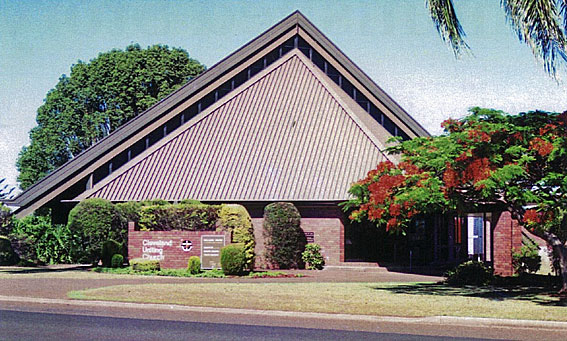
The Uniting Church, Cleveland
[Photograph from Rhelma Morton, Unfinished Story (2009)]

The Uniting Church, Cleveland
[Photograph from Rhelma Morton, Unfinished Story (2009)]
Historical and Technical Documentation by Geoffrey Cox
© OHTA 2011, 2013 (last updated May 2013)
The first Methodist services in Cleveland, a suburb of Brisbane situated on the banks of Moreton Bay, were held in 1908 and a church was built and opened in November 1909 on the corner of Passage and Queen Streets. The old church was relocated to make way for the present church, which was opened on 22 June 1980 by the Moderator of the Queensland Synod of the Uniting Church, Rev. R.W. Elvery.1
Discussions concerning the purchase of an organ began soon after the new church was opened, and by mid-1987 the decision was made to purchase the old organ from the Uniting Church, Clayfield (Wooloowin). The latter was by then in storage following severe storm damage in 1985, and it had been decided not to install it in the new church at Clayfield. The Cleveland church was fortunate to have in the congregation at this time both their organist Ernest Day, an electrician by profession, and the organbuilder David Hudd. By September 1987, the organ had been stored on site in Cleveland. The completed instrument was dedicated by Rev. Barry Dangerfield on Sunday 6 August 1989.2
The organ had been built originally for the Methodist Church, Wooloowin (Clayfield), in 1911 by B.B. Whitehouse & Co. of Brisbane at a cost of £250. It was opened there on Thursday 27 April 1911, the officiating organist for the occasion being Mr S.G. Benson.3 Benson was at that time organist of St Andrew's Presbyterian Church, Creek Street, Brisbane, and formerly organist of the Albert-Street Methodist Church, Brisbane.
Wooloowin Methodist Church Organ Opening.
The pipe organ, built and installed by Messrs B. B. Whitehouse and Co, in the Wooloowin Methodist Church, was formally opened by an organ recital, given by Mr. S. G. Benson, R.A.M. (organist of St Andrew's), on Thursday night. The church was packed to the doors. The new organ was fully tested by the organist, who pronounced the instrument to be perfect of its kind, and well adapted for the work of church music. The audience voiced their enthusiastic appreciation by hearty applause and recall. The organ programme submitted by Mr. Benson contained the following pieces:- "Gland Choeur" (Leigh), "Hymn of Nuns" (Wely), Cantilene (Guilmant), Largo (Handel), "Meditation" (Lemare), and "March Triumphale" (Lemmens). The soloists were Mrs. T. A. Maguire and Mr. A. J. Lewis, the former singing "Sun of My Soul" and "Beloved, it is Morn," with exquisite taste and feeling, the latter being heard with fine effect in "Big Ben." The Rev. J. Bowes, after the dedicatory prayer, announced that the organ was opened free of debt. He paid a tribute to the organ builders, declaring that the church trustees were more than satisfied with the quality of the instrument. He also referred to the help given by Mr. W. M. King who had drawn up the specifications for the organ, and otherwise assisted. Praise was also due to the organ fund treasurers, Messrs. A. J. Littledike and E. L. Paine, who, with Mr S. Knowles, had collected a large proportion of the money. The collection taken, £11, would go towards the cost of the choir stalls. At the conclusion of the recital Mr. Benson was heartily thanked for his services, on the motion of Mr. S. Knowles, seconded by Mr. G. I. Bourne.4
This was one of at least five single-manual mechanical-action instruments built by B.B. Whitehouse & Co around this time, all using divided stops. The others were for the Presbyterian Church, Toowong (October 1909), the Presbyterian Church, Ithaca (late 1907/early 1908) the Methodist Church, Warwick (1909), and the Scots Church, Clayfield (late 1907/early 1908).
The specification of the Wooloowin instrument appears to have been almost identical to that of the organ for the Methodist Church, Warwick, completed in 1909. The main difference between the two was that the Wooloowin organ had a Closed Horn 8ft whereas the Warwick one had a Principal 4ft. Both instruments had six ranks on the Manual, including two divided stops, and one rank on the Pedal. The console at Wooloowin was separated from the organ, with the pulpit between the two and the choir divided on either side.
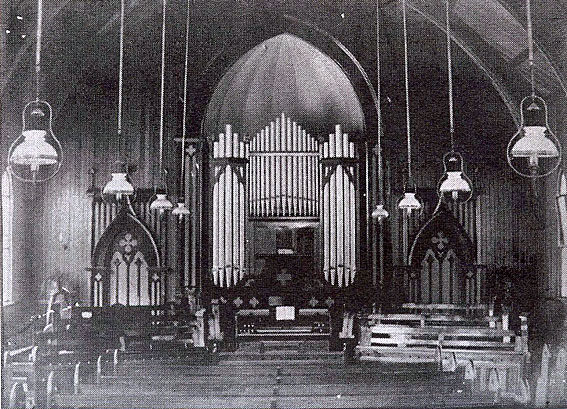
The 1911 B.B. Whitehouse & Co. organ at the Methodist Church, Wooloowin
[Photograph from unidentified source, reproduced in
The Organ Voice, vol. 32, no. 2 (June 2005), p. 19.
The casework, comprising a central flat and two angled towers with decorative braces, appears to have been identical to that of the two-manual organ by B.B. Whitehouse & Co. for the Congregational Church, South Brisbane (December 1910). It differed from the casework for Holy Trinity Anglican Church, Mackay (October 1911) and Holy Trinity Anglican Church, Wooloongabba (February 1912) only in the slightly lower position of the central rail.
The original specification at Wooloowin was recorded in 1934 as follows:
| MANUAL Open Diapason Dulciana Voix Celeste Bass Gedact Treble Gedact Flute Closed Horn Treble Closed Horn Bass PEDAL Bourdon COUPLERS Manual to Pedals Super Octave |
8 8 8 8 8 4 8 8 16 |
Mechanical action
2 composition pedals
Detached draw-stop console.5
The Wooloowin organ was 'rebuilt and modernised' in 1947-48 by Whitehouse Bros at a cost of £2,046.18.0, the specifications having been drawn up in July 1945 and August 1947.6 This was, however, effectively a new organ in the standard mould of the firm's tubular-pneumatic instruments of the time, and it was described as 'new' when opened in February 1948. Only the pipework of the original instrument was retained, and most of the remainder of the old organ found its way in 1950 to the Apostolic Cathedral, Hatton Vale, where it still functions satisfactorily.
Comprising 17 speaking stops, the new organ at Wooloowin was one of the larger instruments built by the firm, comparable in size to their earlier instruments at St Brigid's, Red Hill (1914, 17 stops), St Mary's, Ipswich (1915/1917, 19 stops), the Methodist Church, West End (1924, 19 stops) and the Masonic Temple, Brisbane (1930, 20 stops). The use of a 'blind action' combination system was a particular feature of the instrument, the pistons automatically over-riding the registration set on the stop-keys, but not affecting the setting on the stop-keys themselves.7
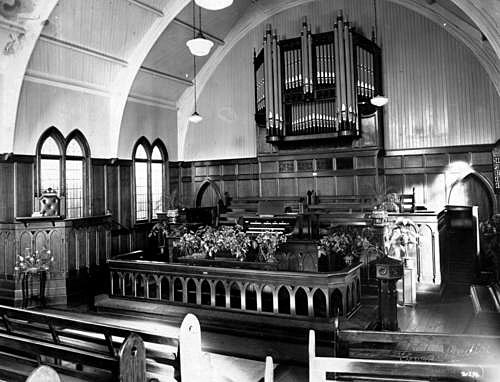
The 1948 Whitehouse Bros organ at the Methodist Church, Wooloowin
[Photograph: John Oxley Library, State Library of Queensland]
The case and console of the 1948 organ were of silky oak, matching the new choir gallery and seats, pulpit and chair, panelling, communion table and rail. These were part of interior renovations completed at the same time, designed by Messrs Christie and Walker Pty Ltd. The organist for the opening services on Sunday 15 February 1948 was Mr Robert Boughen, and an organ recital was given on Monday 23 February by Mr Archie Day,8 the organist of the Albert-Street Methodist Church in Brisbane.
| GREAT Open Diapason Clarabella Stop Diapason Dulciana Principal Clarinet SWELL Violin Diapason Lieblich Gedact Salicional Voix Celestes Flute Piccolo Closed Horn Oboe PEDAL Sub Bass Bourdon Bass Flute COUPLERS Swell to Great Swell to Pedal Great to Pedal Swell to Great Super Swell to Great Sub Swell Super Pedal Octave |
8 8 8 8 4 8 8 8 8 8 4 2 8 8 16 16 8 |
A A |
metal wood wood metal [gvd bass] metal metal [enclosed in Swell box] wood & metal metal metal [gvd bass] metal wood metal metal metal wood wood wood |
General tremulant
Swell tremulant
Tubular pneumatic action
Detached stop-key console
Balanced swell pedal
Radiating concave pedalboard
3 thumb pistons to Great (& cancel)
3 thumb pistons to Swell (& cancel)
1 full-organ piston (& cancel)
Compass: 61/30.9
This organ was placed in storage following storm damage at Clayfield (Wooloowin) in 1985. It was purchased by the Cleveland Uniting Church in 1987, and rebuilt and installed in its present location by Ernest Day with the assistance and oversight of the organbuilder David Hudd, then a member of the congregation. A new organ loft was erected over the church entrance, and new casework was constructed. The action was electrified, and the existing soundboards were modified so that all ranks became full compass. Modifications were made also to the pedal pipes and to the general layout of the instrument to accommodate it under the sloping roof of the building. The organ was dedicated on Sunday 6 August 1989, and the opening recital was given by Steven Nisbet two weeks later.10
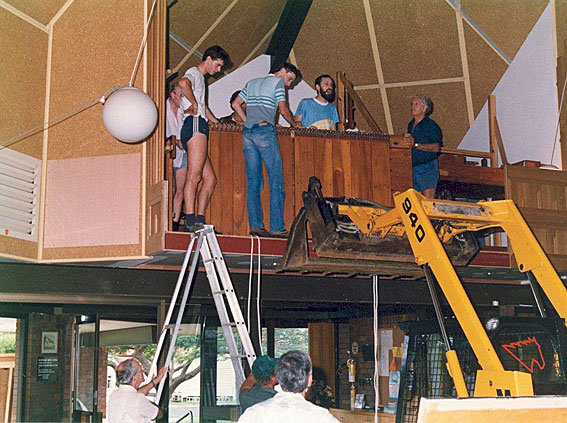
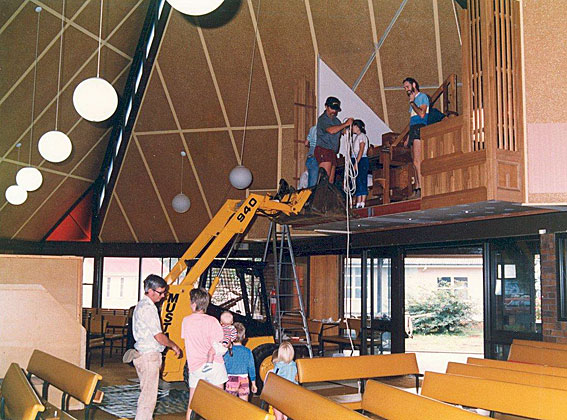
The organ being installed at Cleveland
[Photographs by Ernest Day (1989)]
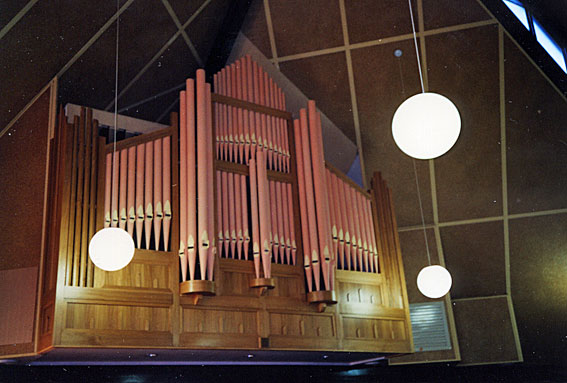
The organ relocated and rebuilt at Cleveland
[Photograph by Howard Baker (1990s)]
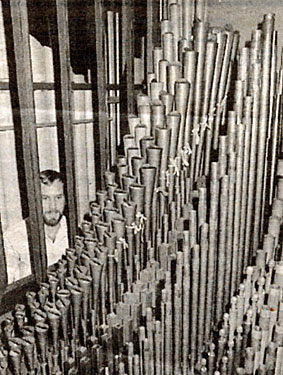
Ernest Day inspecting the Swell pipework at Cleveland
[Photograph: Bayside Bulletin (13 August 1989)]
Additions to the specification in 1989 comprised three complete stops (Great Fifteenth 2ft, Great Mixture II, Swell Gemshorn 4ft), the addition of bass octaves for the Great Dulciana 8ft and Swell Salicional 8ft, and twelve new pipes for Pedal Octave Flute 4ft, all sourced from George Fincham & Son, Melbourne, with whom David Hudd had by then commenced employment. The Fifteenth 2ft was second-hand. The Swell Voix Celeste 8ft and Great Clarinet 8ft were temporarily removed, and the original Great Stop Diapason 8ft was transposed to become a Flute 4ft. A new capture system was supplied by Messrs Brown & Arkley, and a new console was made by Ernest Day.11
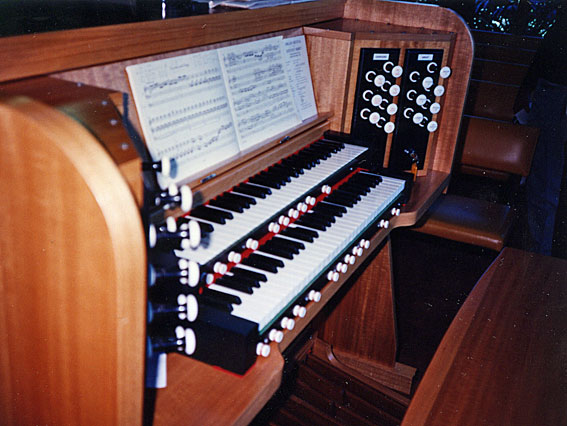
The 1989 console made by Ernest Day
[Photograph by Howard Baker (1990s)]
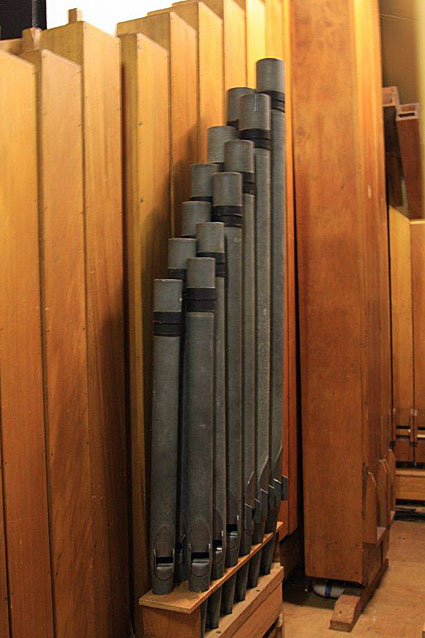
The new bottom octave of the Great Dulciana 8ft, in front of the Pedal Bourdon 16ft
[Photograph by Ernest Day (2012)]
In 1990, the disused Great Clarinet 8ft was temporarily re-installed (un-enclosed) on the Great on a separate soundboard. It was subsequently re-fashioned by George Fincham & Son of Melbourne into a Great Trumpet 8ft (initially for use also on the Pedal), and installed on a new four-stop electro-pneumatic Great soundboard made in 1995 by Ernest Day.12
The organ was further enlarged in 2005-07 by Ernest Day & Bill McKelvie. Additional pipework was acquired at this time from various sources: The pipes for the Pedal Principal 8ft and Gamba 8ft came from the organ at St Paul's Anglican Church, Chatswood, NSW (British Pianoforte Depot Ltd, 1909), which had been broken up in the mid 1970s.13 The Pedal Fifteenth 4ft and Mixture III were made up of pipes from a dismantled fairground organ in Melbourne, from St Paul's, Chatswood, and from the Majestic Theatre at Pomona, Qld. A second-hand three-rank Mixture from the USA was divided to provide a Swell two-rank Mixture and to increase the 1989 Great Mixture to 3 ranks. The pipes for the Great Twelfth 2-2/3ft came from St Paul's, Chatswood, and the Great Flute 4ft (open, wooden) was remade from part of a Stopped Diapason rank (Whitehouse, 1913) retrieved from St Barnabas' Anglican Church, Ithaca, after a fire there is 1994. The Swell Nasard 2-2/3ft had formerly been the Great Flute 4ft (1989) which had, in turn, been transposed from the Stop Diapason 8ft (1911). The Pedal Trombone 16ft (extended to 8ft) and Clarion 4ft, which have wooden resonators, were made entirely by members of the congregation. A four-rank Pedal soundboard, new enlarged blower and wind trunking were made by Ernest Day. New Great and Swell soundboard puffers were manufactured and installed by Bill McKelvie.14
The enlarged organ was opened with a recital by Dr Robert Boughen on Sunday 24 June 2007, significantly recognising his involvement with the instrument a half century earlier.15
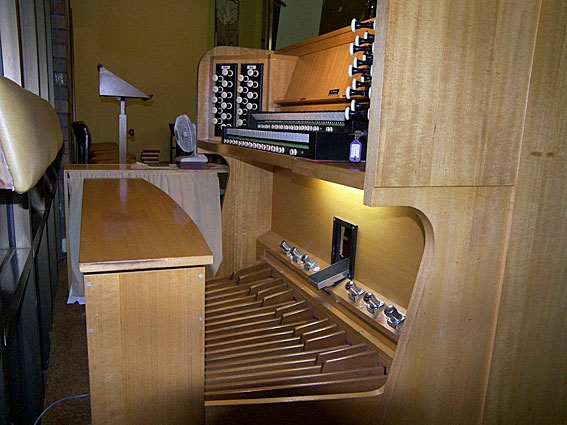
The 1989 console following additions in 2007
[Photograph by Ernest Day (2012)]
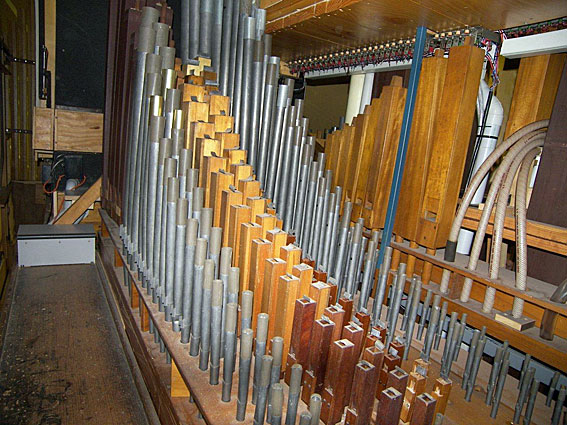
The Great soundboard, showing L to R: Open Diapason 8ft, Clarabella 8ft,
Flute 4ft, Dulciana 8ft and Principal 4ft, with the additional 4-stop
soundboard above, and the Pedal Bourdon 16ft behind
[Photograph by Stan Goleby (2010)]
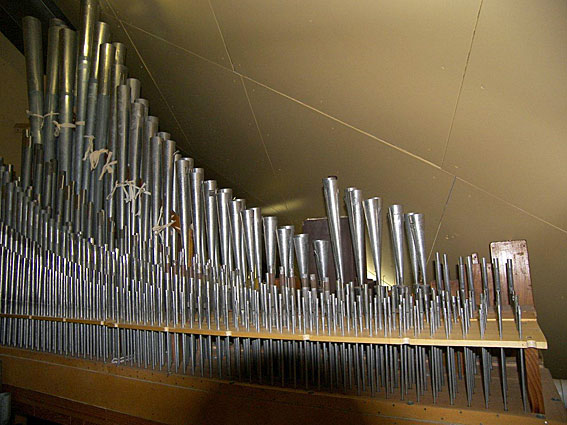
The additional Great soundboard, showing front to back: Mixture III,
Fifteenth 2ft, Twelfth 2-2/3ft, Trumpet 8ft
[Photograph by Stan Goleby (2010)]
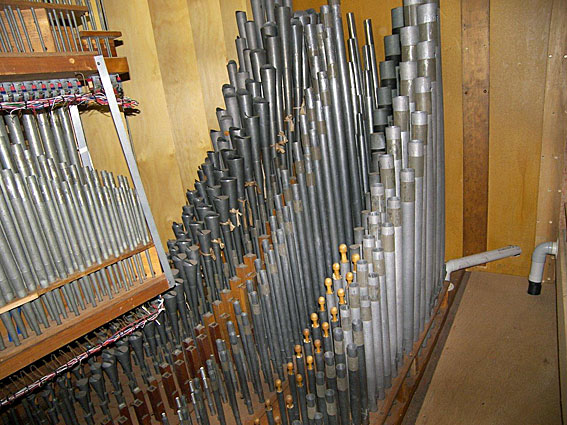
The Swell soundboard, showing L to R: Oboe 8ft, Closed Horn 8ft, Piccolo 2ft, Flute 4ft,
with Gemshorn 4ft, Salicional 8ft, Gedact 8ft, Violin Diapason 8ft, Mixture II (above left)
[Photograph by Stan Goleby (2010)]
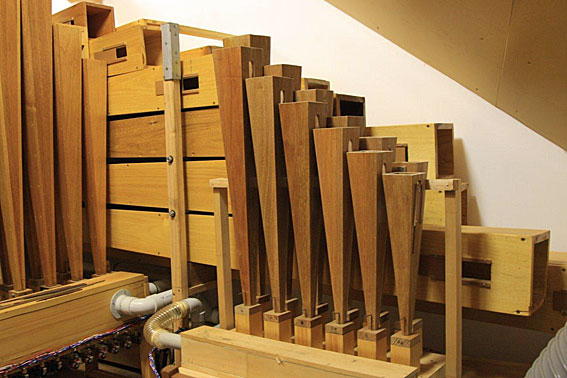
The Pedal Trombone 16ft and Trumpet 8ft pipes on a separate soundboard,
showing the bottom 12 pipes of the Trombone 16ft installed horizontally
[Photograph by Ernest Day (2012)]
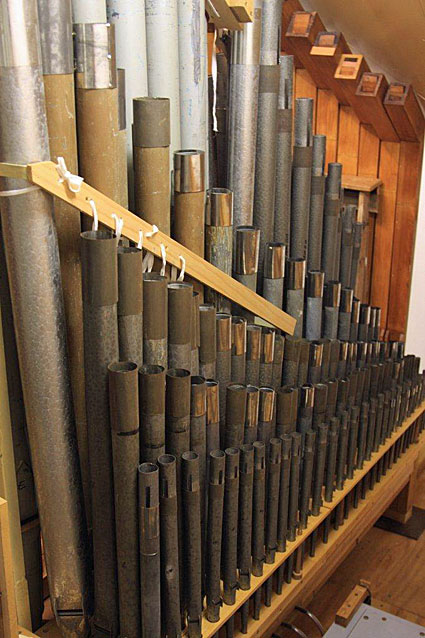
The back of the Pedal soundboard, showing the Mixture III in the foreground,
with the Fifteenth 4ft, Principal 8ft and Gamba 4ft behind, and the
bottom octave of the Swell Violin Diapason 8ft in the background
[Photograph by Ernest Day (2012)]

The front of the Pedal soundboard, showing the Clarion 4ft and Gamba 8ft.
The grey painted pipes were formerly façade pipes in the organ of
St Paul's Anglican Church, Chatswood
[Photograph by Ernest Day (2012)]
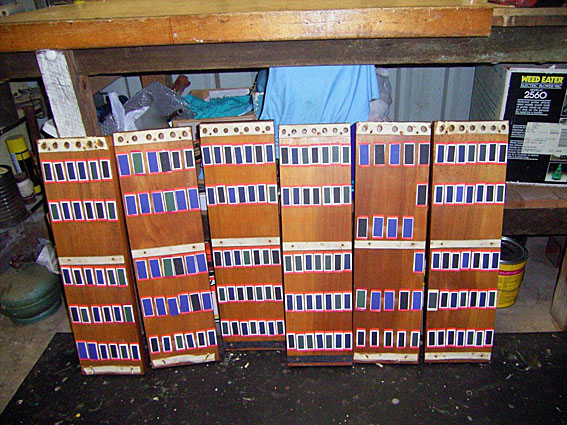
Set of puffer boards with replaced puffers, ready to be reinstalled
[Photograph by Ernest Day (2007)]
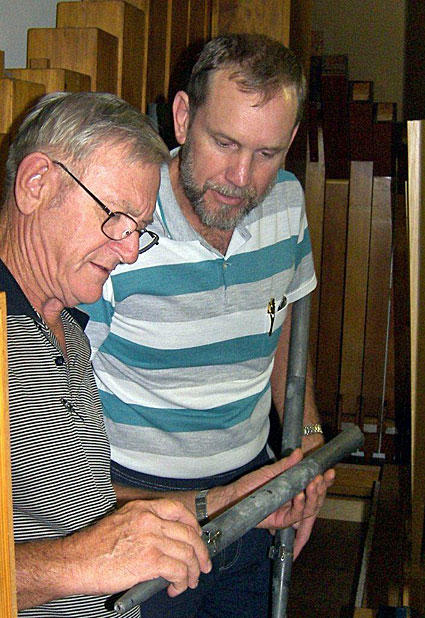
Bill McKelvie and Ernest Day inspecting one of the Pedal Mixture pipes
[Photograph by Stan Goleby (2010)]
The resulting specification is as follows:
| GREAT Open Diapason Clarabella Dulciana Principal Flute Twelfth Fifteenth Mixture Trumpet SWELL Violin Diapason Gedact Salicional Vox Celeste Gemshorn Flute Nasard Piccolo Mixture Closed Horn Oboe PEDAL Bourdon Echo Bourdon Principal Gamba Bass Flute Fifteenth Octave Flute Mixture Trombone Trumpet Clarion COUPLERS Swell to Great Swell to Pedal Great to Pedal Swell Octave Swell Sub Octave Swell Unison Off |
8 8 8 4 4 2-2/3 2 III 8 8 8 8 8 4 4 2-2/3 2 II 8 8 16 16 8 8 8 4 4 III 16 8 4 |
A A A B B |
[1911] [1948] [1911; bottom octave 1989] [1948] [2007] [2007] [1989] [II ranks, 1989; III ranks 2007] [2007; formerly Clarinet 8ft, (1948)] [1948] [1948?] [1948; bottom octave 1989] [1911; removed 1989; reinstated 2009] [1989] [1911?] [2007; formerly Great Flute 4ft (1989), and previously Stop Diapason 8ft (1911)] [1948] [2007] [1911] [1948] [1948] [1911] [2007] [2007] [1911/1948] [2007] [1989] [2007] [2007] [2007] [2007] |
Swell tremulant
Electro-pneumatic action
Detached stop-key console
Balanced swell pedal
Radiating concave pedalboard
7 thumb pistons to Great Organ
7 thumb pistons to Swell Organ
2 toe pistons to Pedal Organ
8 general toe pistons
1 full-organ piston thumb piston
1 full-organ toe piston
Compass: 61/30.16
The instrument has become the catalyst for a local program of cultural events including organ recitals, of which the first was given in 2009 by Christopher Wrench.17
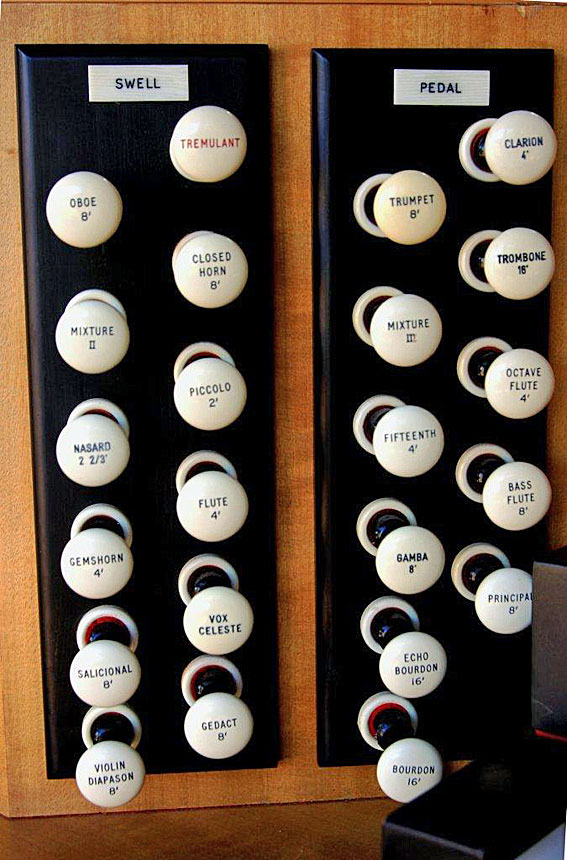
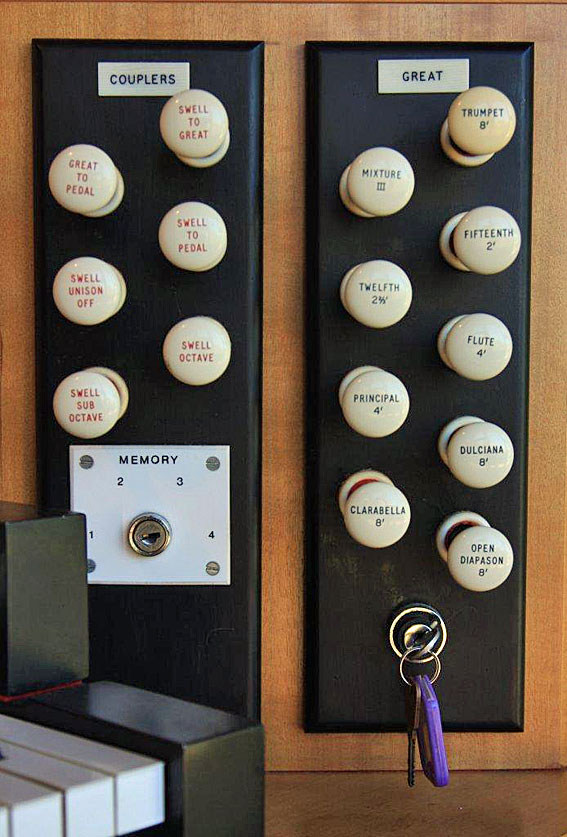
Stop jambs
[Photographs by Ernest Day (2012)]
_________________________________________________________________________
1 Rhelma Morton, Unfinished Story: Cleveland Uniting Church, The first 100 years of worship, witness and service, 1909-2009 (Cleveland: Cleveland Uniting Church, 2009), pp. 1-3, 25-29.
2 Morton, op. cit, pp. 32, 34, 72; Personal communication to G. Cox from Ernest Day, April 2012.
3 Ian Tucker, 'First Ten Years at Wooloowin,' Testimony: The Official Record of the Queensland Methodist Historical Society, vol. 10 (1973), p. 19; The Brisbane Courier (27 April 1911), p. 7.
4 The Brisbane Courier (29 April 1911), p. 4.
5 Original specification noted July 1934 in Notebooks of Mr E.R. Salisbury.
6 Whitehouse Bros Ledger (1940-1954), p. 317.
7 Collected Organ Specifications of Bernie Brohan (c.1952)
8 Programme for 'Opening Services and Dedication of the New Organ, Sunday, February 15th, 1948,' kindly supplied by Robert Boughen, c.1974.
9 Specification from Opening Program, 15 February 1948, and as noted by G. Cox, January 1973; with some additional details from Collected Organ Specifications of Bernie Brohan (c.1952).
10 Bayside Bulletin, vol. 5, no. 36 (Tuesday 15 August 1989).
11 1989 rebuild details supplied to G. Cox by David Hudd, 1988, and Ernest Day, 2012.
12 Personal communication to G. Cox from Ernest Day, April 2012.
13 Graeme Rushworth, Historic Organs of New South Wales: The Instruments, Their Makers and Players, 1791-1940 (Sydney: Hale & Iremonger, 1988), pp. 151-153, 156.
14 Personal communication to G. Cox from Ernest Day, April 2012.
15 David Vann, 'Cleveland Uniting Church: An Organ Enlargement,' Organ Australia, vol. 2, no. 3 (September 2007), pp. 31-32.
16 Specification from photographs of stop jambs supplied by Ernest Day, with additional details from personal communication to G. Cox from Ernest Day, April 2012.
17 David Vann, 'A Local Success Story,' Organ Australia, vol. 5, no. 2 (June 2009), p. 8.